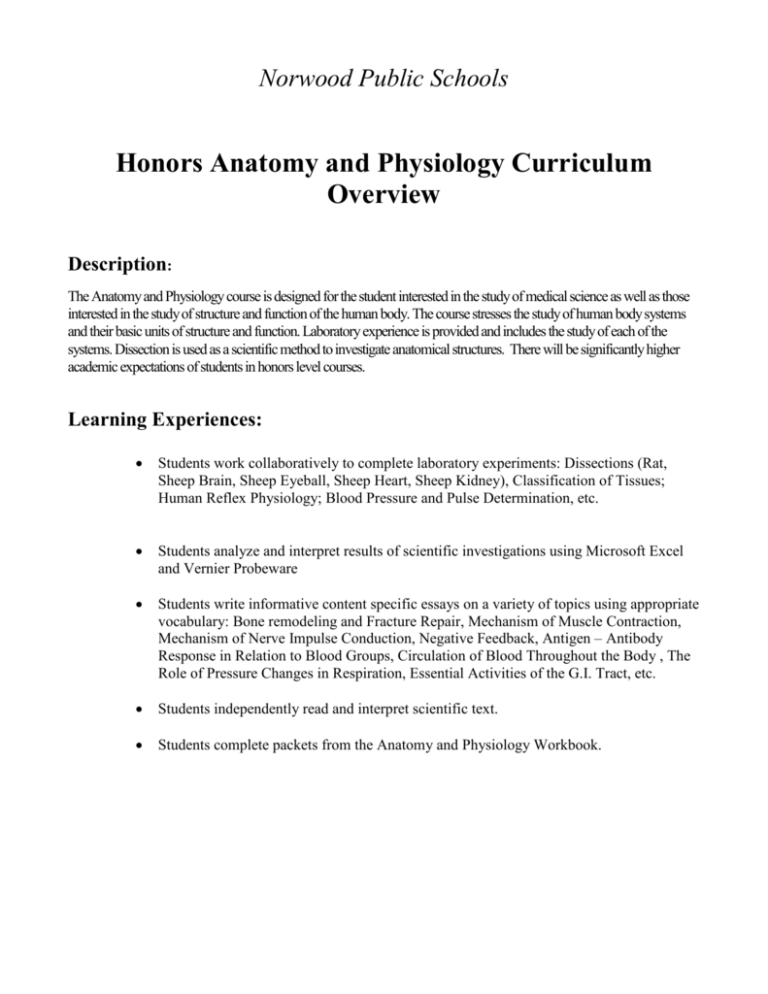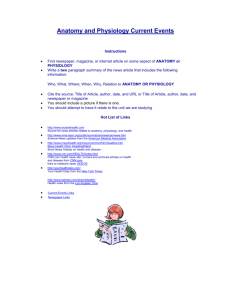Honors Anatomy and Physiology Curriculum Overview
advertisement

Norwood Public Schools Honors Anatomy and Physiology Curriculum Overview Description: The Anatomy and Physiology course is designed for the student interested in the study of medical science as well as those interested in the study of structure and function of the human body. The course stresses the study of human body systems and their basic units of structure and function. Laboratory experience is provided and includes the study of each of the systems. Dissection is used as a scientific method to investigate anatomical structures. There will be significantly higher academic expectations of students in honors level courses. Learning Experiences: • Students work collaboratively to complete laboratory experiments: Dissections (Rat, Sheep Brain, Sheep Eyeball, Sheep Heart, Sheep Kidney), Classification of Tissues; Human Reflex Physiology; Blood Pressure and Pulse Determination, etc. • Students analyze and interpret results of scientific investigations using Microsoft Excel and Vernier Probeware • Students write informative content specific essays on a variety of topics using appropriate vocabulary: Bone remodeling and Fracture Repair, Mechanism of Muscle Contraction, Mechanism of Nerve Impulse Conduction, Negative Feedback, Antigen – Antibody Response in Relation to Blood Groups, Circulation of Blood Throughout the Body , The Role of Pressure Changes in Respiration, Essential Activities of the G.I. Tract, etc. • Students independently read and interpret scientific text. • Students complete packets from the Anatomy and Physiology Workbook. Content Outline: Term 1: The Human Body: An Orientation: An Overview of Anatomy and Physiology, The Language of Anatomy Cells and Tissues: Epithelial Tissue, Connective Tissue, Muscle Tissue, Nervous Tissue Skin and Body Membranes: Classification of Membranes, Integumentary System The Skeletal System: Bones, Axial Skeleton, Appendicular Skeleton, Joints Term 2: The Muscular System: Muscle Types and Functions, Movements, Microscopic Anatomy, Gross Anatomy The Nervous System: Organization, Central Nervous System, Peripheral Nervous System Special Senses: Eye and Vision, Ear, Hearing and Balance, Chemical Senses Term 3: The Endocrine System: Overview, Major Endocrine Organs, Other Hormone Producing Tissues Blood: Composition and Function, Hemostasis, Blood Groups and Transfusions The Cardiovascular System: Heart, Blood Vessels, Physiology of Circulation The Respiratory System: Functional Anatomy, Respiratory Physiology Term 4: The Digestive System and Body Metabolism: Anatomy, Functions, Nutrition and Metabolism The Urinary System: Kidneys; Ureters, Urinary Bladder, Urethras; Fluid, Electrolyte, and Acid-Base Balance The Reproductive System: Anatomy of the Male Reproductive System, Male Reproductive Functions, Anatomy of the Female Reproductive System, Female Reproductive Functions and Cycles, Pregnancy and Embryonic Development Resources Used: • Text: Essentials of Human Anatomy/ Elaine N. Marieb. – 7th Edition 2003 • Laboratory Manual: Essentials of Human Anatomy/ Elaine N. Marieb. – 2nd Edition 2002 • Anatomy and Physiology Coloring Workbook: A Complete Study Guide/Elaine N. Marieb – 7th Edition 2003 • Human Physiology with Vernier; Diana Gordon, Stephen L. Gordon M.D.; Vernier Software & Technology; 2008 As of 3/16/2012







